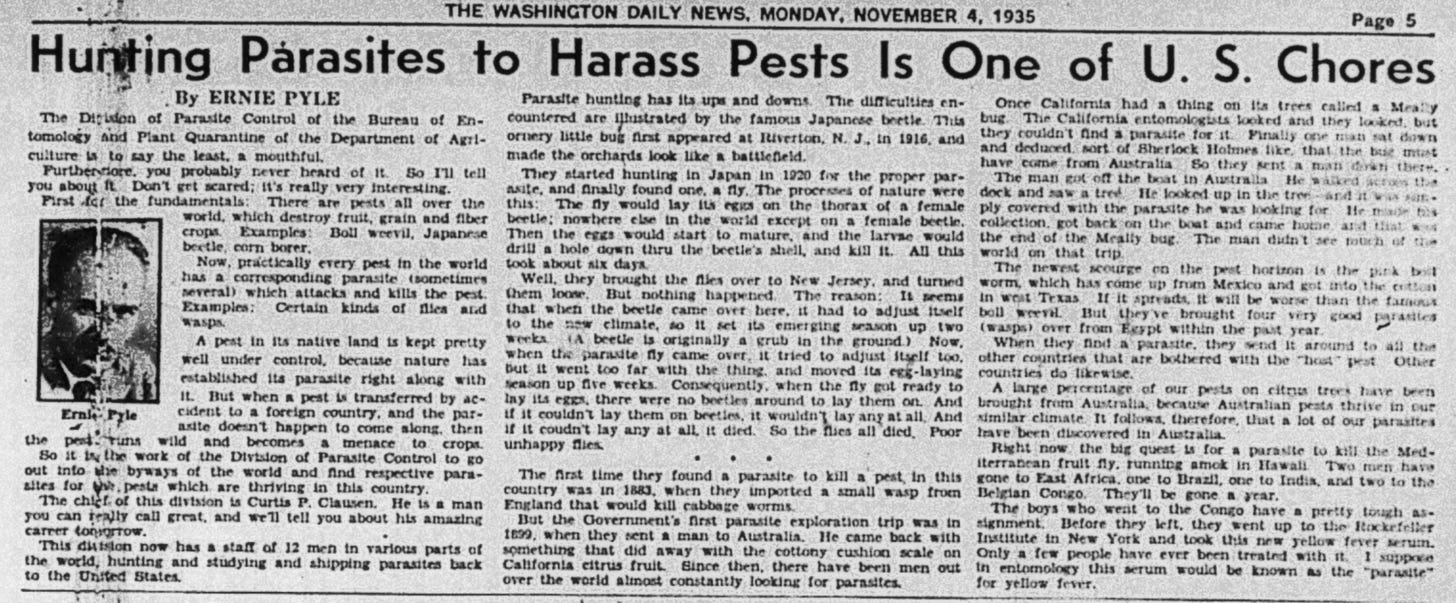Curtis P. Clausen, Department of Agriculture
The Washington Daily News – Monday, November 4, 1935
Hunting Parasites to Harass Pests Is One of U.S. Chores
By Ernie Pyle
The Division of Parasite Control of the Bureau of Entomology and Plant Quarantine of the Department of Agriculture is, to say the least, a mouthful.
Furthermore, you probably never heard of it. So I’ll tell you about it. Don’t get scared; it’s really very interesting.
First, the fundamentals: There are pests all over the world, which destroy fruit, grain and fiber crops. Examples: Boll weevil, Japanese beetle, corn borer.
Now, practically every pest in the world has a corresponding parasite (sometimes several) which attacks and kills the pest. Examples: Certain kinds of flies and wasps.
A pest in its native land is kept pretty well under control, because nature has established its parasite right along with it. But when a pest is transferred by accident to a foreign country, and the parasite doesn’t happen to come along, the pest runs wild and becomes a menace to crops.
So it is the work of the Division of Parasite Control to go to the side bypaths of the world and find respective parasites for the pests which are thriving in this country.
The chief of this division is Curtis P. Clausen. He is a man you can really call great, and we’ll tell you about his amazing career tomorrow.
This division now has a staff of 12 men in various parts of the world, hunting and studying and shipping parasites back to the United States.
Parasite hunting has its ups and downs. The difficulties encountered are illustrated by the famous Japanese beetle. This ornery little bug first appeared at Riverton, N.J., in 1916, and made the orchards look like a battlefield.
They started hunting in Japan in 1920 for the proper parasite, and finally found one, a fly. The processes of nature were this: The fly would lay its eggs on the thorax of a female beetle; nowhere else in the world except on a female beetle. Then the eggs would start to mature, and the larvae would drill a hole down through the beetle’s shell, and kill it. All this took about six days.
Well, they brought the flies over to New Jersey, and turned them loose. But nothing happened. The reason: It seems that when the beetle came over here, it had to adjust itself to the new climate, so it set its emerging season up two weeks. (A beetle is originally a grub in the ground.) Now, when the parasite fly came over, it tried to adjust itself too, but it went too far with the thing and moved its egg-laying season up five weeks. Consequently, when the fly got ready to lay its eggs, there were no beetles around to lay them on. And if it couldn’t lay them on beetles, it wouldn’t lay any at all. And if it couldn’t lay any at all, it died. So the flies all died. Poor unhappy flies.
The first time they found a parasite to kill a pest in this country was in 1883, when they imported a small wasp from England that would kill cabbage worms.
But the Government’s first parasite exploration trip was in 1899, when they sent a man to Australia. He came back with something that did away with the cottony cushion scale on the California citrus fruit. Since then, there have been men out over the world almost constantly looking for parasites.
Once California had a thing on its trees called a Mealy bug. The California entomologists looked and they looked, but they couldn’t find a parasite for it. Finally one man sat down and deduced, sort of Sherlock Holmes like, that the best must have come from Australia. So they sent a man down there.
The man got off the boat in Australia. He saw a tree. He looked up in the tree. It was simply covered with the parasite he was looking for. He took his collection, got back on the boat and came home—all in 48 hours. The man didn’t see much of the world on that trip.
The newest scourge on the pest horizon is the pink boll worm, which has come up from Mexico and got into the cotton in west Texas. If it spreads, it will be worse than the regular boll weevil. But they’ve brought four very good parasites (wasps) over from Egypt within the past year.
When they find a parasite, they send it around to all the other countries that are bothered with the “host” pest. Other countries do likewise.
A large percentage of our pests on citrus trees have been brought from Australia, because Australian pests thrive in our similar climate. It follows, therefore, that a lot of our parasites have been discovered in Australia.
Right now the big quest is for a parasite to kill the Mediterranean fruit fly, running amok in Hawaii. Two men have gone to East Africa, one to Brazil, one to India, and two to the Belgian Congo. They’ll be gone a year.
The boys who went to the Congo have a pretty tough assignment. Before they left, they went up to the Rockefeller Institute in New York and took this new yellow fever serum. Only a few people have ever been treated with it. I suppose in entomology this serum would be known as the “parasite” for yellow fever.
💛 **Enjoyed this post?** Your support helps us continue to transcribe and promote Ernie’s work. Please click the link below to donate.





